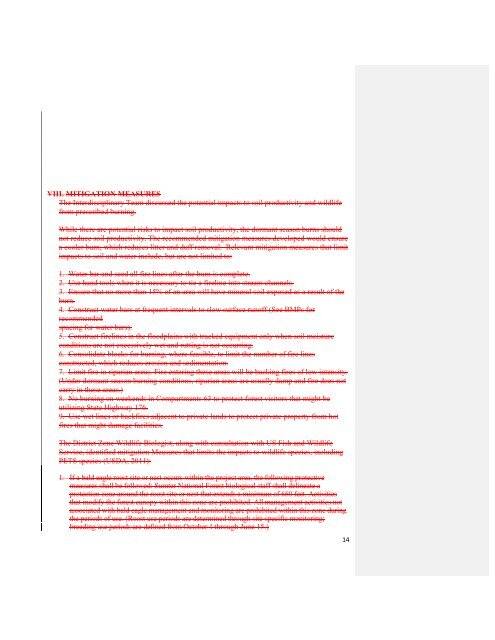DECISION MEMO Prescribed Burn and Commercial Thinning ...
DECISION MEMO Prescribed Burn and Commercial Thinning ...
DECISION MEMO Prescribed Burn and Commercial Thinning ...
You also want an ePaper? Increase the reach of your titles
YUMPU automatically turns print PDFs into web optimized ePapers that Google loves.
VIII. MITIGATION MEASURES<br />
The Interdisciplinary Team discussed the potential impacts to soil productivity <strong>and</strong> wildlife<br />
from prescribed burning.<br />
While there are potential risks to impact soil productivity, the dormant season burns should<br />
not reduce soil productivity. The recommended mitigation measures developed would ensure<br />
a cooler burn, which reduces litter <strong>and</strong> duff removal. Relevant mitigation measures that limit<br />
impacts to soil <strong>and</strong> water include, but are not limited to:<br />
1. Water bar <strong>and</strong> seed all fire lines after the burn is complete.<br />
2. Use h<strong>and</strong> tools when it is necessary to tie a fireline into stream channels.<br />
3. Ensure that no more than 15% of an area will have mineral soil exposed as a result of the<br />
burn.<br />
4. Construct water bars at frequent intervals to slow surface runoff (See BMPs for<br />
recommended<br />
spacing for water bars).<br />
5. Construct firelines in the floodplains with tracked equipment only when soil moisture<br />
conditions are not excessively wet <strong>and</strong> rutting is not occurring.<br />
6. Consolidate blocks for burning, where feasible, to limit the number of fire lines<br />
constructed, which reduces erosion <strong>and</strong> sedimentation.<br />
7. Limit fire in riparian areas. Fire entering these areas will be backing fires of low intensity.<br />
(Under dormant season burning conditions, riparian areas are usually damp <strong>and</strong> fire does not<br />
carry in these areas.)<br />
8. No burning on weekends in Compartments 63 to protect forest visitors that might be<br />
utilizing State Highway 176.<br />
9. Use wet lines or backfires adjacent to private l<strong>and</strong>s to protect private property from hot<br />
fires that might damage facilities.<br />
The District Zone Wildlife Biologist, along with consultation with US Fish <strong>and</strong> Wildlife<br />
Service, identified mitigation Measures that limits the impacts to wildlife species, including<br />
PETS species (USDA, 2011):<br />
1. If a bald eagle roost site or nest occurs within the project area, the following protective<br />
measures shall be followed: Sumter National Forest biological staff shall delineate a<br />
protection zone around the roost site or nest that extends a minimum of 660 feet. Activities<br />
that modify the forest canopy within this zone are prohibited. All management activities not<br />
associated with bald eagle management <strong>and</strong> monitoring are prohibited within this zone during<br />
the periods of use. (Roost use periods are determined through site-specific monitoring;<br />
breeding use periods are defined from October 1 through June 15.)<br />
14

















